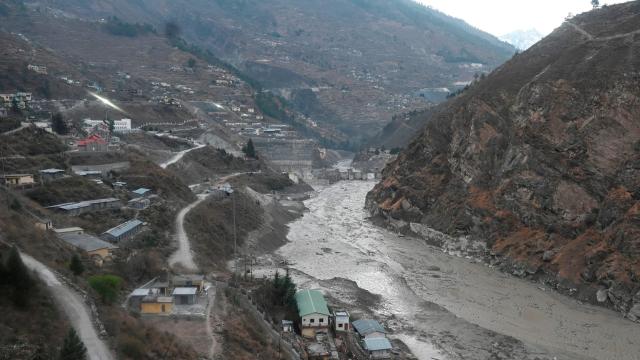In February, a massive avalanche tore through a mountain valley in the northern Indian state of Uttarakhand, causing flash flooding and mudslides. A new study has found that debris broke off a glacier above the valley and disintegrated so quickly that the resulting friction melted ice around it, causing the enormous, deadly wave of water.
Dramatic footage of the disaster showed a torrent of debris and water thundering down a river and crashing right through a dam. The disaster left 200 dead, many of them workers at the two hydropower plants along the river that collapsed and trapped people inside.
Initial local reports said that a chunk of the nearby Nanda Devi Glacier had broken off and fallen into a nearby river, prompting the avalanche. But there was “a lot of confusion and a lot of really bad terminology going around” in the media in the days after the flood, said Dan Shugar, an associate professor of geoscience at the University of Calgary and a coauthor of the new study. He and a team of other scientists got together to figure out what really happened.
The resulting study, published this week in Science, used satellite and seismic data, video footage, and digital modelling to piece together what caused the crisis. The two things the scientists set out to solve in this glacial whodunit were, said Shugar, “what was the cause of the event, and where did all the water come from?”
Usually, surges of water like those observed in February are associated with what’s called a glacial lake outburst flood. Those occur when the natural dam at the snout of a glacier that lakes can form behind weakens and eventually fails, sending a wall of water down the valley. But there was no evidence of a glacial lake in the satellite imagery, nor any telltale fingerprints on the landscape usually left by a glacial lake outburst flood. Shugar noticed a “cloud of dust snaking along the valley” that he saw in initial satellite images as well as chunks of the mountain that seemingly disappeared the day before and after the event.
“We have a landslide that’s playing some role here, but then where the hell is all the water from?” Shugar said.
Shugar and his team went through all the possible sources of that wave of water, crossing them off one by one. Using all the available information, the most probable scenario they landed on is pretty wild. Of the 27 million cubic meters of stuff that careened down the mountain that day, around 80% was bedrock, while only 20% was actual ice. That means what fell was that’s called a hanging glacier.
“It’s plastered to the side of a mountain, very steep, almost like a tooth of ice stuck onto the side of the mountain,” Shugar said. Hanging glaciers collapsing is not totally unusual — at this particular site, another hanging glacier had collapsed a couple of years ago — but having this amount of bedrock fall is novel.
“When the bedrock falls, it disintegrates rapidly [from] more or less solid bedrock down to clay particles extremely quickly,” Shugar said. “The frictional energy that’s produced and released is in the form of heat. The calculations that some of my coauthors did show that the ratio of rock and ice here combined with the incredible fall height that we saw was almost exactly enough to melt all the ice.”
In other words, the bedrock fell apart so fast that the heat melted the ice, causing a huge gush of water that came thundering along with the wave of dust. When most people these days hear that a glacial collapse caused a disaster, their brains automatically go to climate change, but this may be a case of geologic hijinks without absolute proof that warming played a role. Shugar said his team lacked the type of location-specific temperature data they’d need to definitively tie the collapse to climate change.
“It’s really, really hard to link this unequivocally to climate change. We can’t do it,” he said. “Climate change may have played a role here, but we can’t conclusively say ‘yes’ or ‘no.’”
However, the disaster does highlight how unpredictable glacial regions can be, especially when humans build infrastructure in sensitive areas. The huge death toll and massive wave of destruction is a warning sign for glacial regions that are rapidly changing and becoming more unstable.
“As the climate is changing, we do expect more large hazardous events like this, and when people are in the way, they’ll become disasters,” Shugar said. “Maybe the hanging glacier in this case did play a role by introducing more meltwater into the slope, maybe permafrost played a role, we can’t really say. But going forward, we expect more of these kinds of disasters. When we’re thinking about large-scale infrastructure, whether that’s a hydroplant in Asia or a pipeline in North America, we need to be thinking about not just what these mountain landscapes look like today, but what they’re going to look like in 20 years, 50 years. We need to be thinking about these landscapes as dynamic.”
